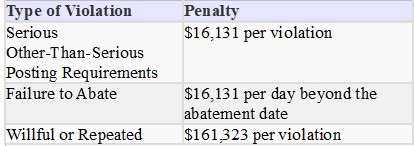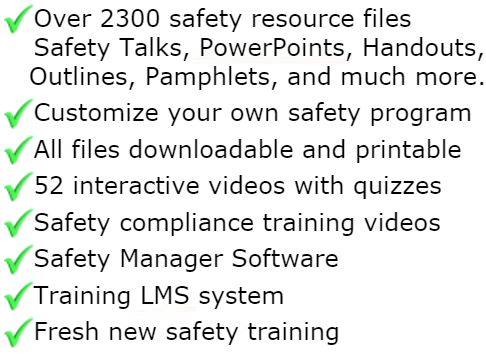
Vehicle Fleet Safety Management
This is a sample or partial document
Download the full customizable and printable version
Preventable Vehicle Accidents
Objective: To reduce motor carrier fleet accident rates by establishing a company standard for safe driving.
Description: A preventable accident is one which occurs because the driver fails to act in a reasonably expected manner to prevent it. In judging whether the driver's actions were reasonable, one seeks to determine whether the driver drove defensively and demonstrated an acceptable level of skill and knowledge. The judgment of what is reasonable can be based on a company-adopted definition, thus establishing a goal for its safety management programs.
Note that the above definition of preventable accident is focused on the actions of the driver. It is the commonly used definition in evaluating driver performance. A broader definition, which can be used to evaluate the driver's and the motor carrier's actions, is given by the Federal Motor Carrier Safety Regulations as follows: Preventable accident on the part of a motor carrier means an accident (1) that involved a commercial motor vehicle, and (2) that could have been averted but for an act, or failure to act, by the motor carrier, or the driver.
The concept of a preventable accident is a fleet safety management tool which achieves the following goals:
• It helps establish a safe driving standard for the driver.
• It provides a criterion for evaluating individual drivers.
• It provides an objective for accident investigations and evaluations.
• It provides a means for evaluating the safety performance of individual drivers and the fleet as a whole.
• It provides a means for monitoring the effectiveness of fleet safety programs.
• It assists in dealing with driver safety infractions.
• It assists in the implementation of safe driving recognition programs.
Management:
• Does the company have a program for investigating accidents ?
• Is there a company accident review committee ?
• Has the company defined a standard for the safe driving performance of its drivers ?
• Is the carrier's standard for safe driving performance sufficiently challenging such that it would serve to highlight areas for fleet safety improvement ?
• Are the drivers instructed as to what the company standard for safe driving is ?
• Are the drivers instructed about company procedure for evaluating the preventability of accidents?
DRIVER QUALIFICATIONS AND PERFORMANCE
Objective: To improve motor carrier fleet safety by recruiting qualified drivers and monitoring the performance and qualifications of existing drivers.
Description: The great majority of preventable accidents can be shown to be directly related to the performance of the driver. It is therefore extremely productive to any fleet safety program to have careful new driver selection and adequate monitoring procedures for existing drivers.
Management:
When hiring new drivers:
• Are recruiting efforts sufficient to attract an adequate number of qualified applicants for
• effective selection?
• Is there an established formal procedure for interviewing, testing and screening applicants?
• Is there a defined standard of skill and knowledge to be met by successful applicants?
• Are appropriate methods being utilized to check out previous employment history and references?
• Is the prior driving record being checked?
• Are the applicants' physical qualifications checked?
Monitoring existing drivers' qualifications:
• Is there a formal program for monitoring drivers' qualifications ?
• Is there a periodic review of the driving record ?
• Is there a periodic review of the drivers' health ?
• Are drivers monitored for drug and alcohol abuse ?
• Is there a means for identifying deficiencies in drivers' skills and knowledge and a procedure for remedial training ?
• Is there an established procedure for terminating unqualified drivers ?
SAFE DRIVING RECOGNITION
Objective: To encourage safe driving and improve driver awareness of safety.
Description: Safe driving recognition or incentive programs should be an integral part of a formal fleet safety program. Such programs identify superior driving performance and set forth the selected drivers as examples to be emulated by the rest of the fleet. Such programs can be generated internally within the company or through participation in national safe driver award programs conducted by associations such as the National Safety Council or the American Trucking Associations.
Management:
• Does the company have a formal safe driver recognition and incentive program?
• Is there participation in a company driver recognition program or in national award programs?
• Does the company have a means for evaluating driver performance?
• Use safe driving recognition to:
- encourage safe driving performance- heighten driver safety awareness
- foster driver professionalism
- focus the monitoring of individual driver performance and skills
- help monitor fleet performance and effectiveness of the fleet safety program
DRIVER SAFETY INFRACTIONS
Objective: To improve fleet safety by remedial training or termination of unqualified drivers.
Description: Driving is a profession requiring skill, knowledge, physical and mental health and character integrity. Public safety and company reputation requires that drivers be fully qualified. Drivers who are not qualified should receive remedial training or be terminated if they cannot be brought up to the necessary level of competence.
Management:
• Does the carrier have a formal review program for driver qualification ?
• Do all the drivers meet the FMCSR qualification requirements ?
• Does the company have a standard for safe driving ?
• Is there a company policy for issuing reprimands and terminations ?
• Is a progressive disciplinary action a feature of the policy ?
• Are remedial training programs available ?
• Is remedial training included in the progressive discipline ?
DRINKING AND SUBSTANCE ABUSE
Objective: To prevent accidents caused by drivers under the influence by identifying and controlling abusers.
Description: It has been well documented that drivers under the influence of alcohol or drugs have been involved in about half of all fatal traffic accidents. Drinking or substance abuse by drivers of alcohol or drugs cannot be tolerated. Company management must be acutely aware of the seriousness of this societal problem and establish procedures to effectively control it within their respective organizations.
Management:
Are the driving records and references of new-hire applicants checked thoroughly for evidence of drinking or substance abuse problems?
• Has a written policy been established which stipulates countermeasures that will be followed when dealing with abusers?
• Has a formal policy been made known to all drivers?
• Do drivers' immediate supervisors and dispatchers know how to identify personnel under the influence?
• Are immediate supervisors and dispatchers motivated to notify management about problem drivers?
• Has management educated drivers about the ways in which drinking and substance abuse affect driving performance?
• Does the company have a list of references and potential sources for help available to drivers?
• Be aware of marked changes in work behavior, personal relations, emotional moods and appearance of your drivers.
• Immediate supervisors are in the best position to observe unusual driver behavior.
• Do a thorough job in screening applicants regarding drinking and substance abuse. Your company can't afford to deal with the problems abusers will give you.
Drivers:
• Don't drink and drive.
• Don't abuse drugs, legal or illegal.
• Find out if prescription or over-the-counter medications may adversely affect safe driving.
• Get help fast if you have, or think you may have an abuse problem.
ILLNESS AND FATIGUE
Objective: To prevent accidents caused by ill and fatigued drivers through the use of common sense and by compliance with FMCSR's regarding physical qualifications and hours-of-service.
Description: Everyone understands how ill or fatigued drivers can be a hazard to themselves and others. Nonetheless, drivers sometimes push their bodies beyond reasonable limits and become a hazard anyway. This is why comprehensive federal regulations have been established. In addition to being law, these regulations are useful guides to both the driver and his supervisors in defining reasonable, sensible limitations on when medical conditions or duty status calls for rest and no driving.
Management:
Are supervisors fully aware of all the FMCSR's which relate to physical qualifications, medical examinations and hours-of-service?
• Are maximum on-duty and driving times clearly spelled out to your drivers?
• Do you cross-check driver-logs with odometer readings, fuel receipts and weight scale tickets?
• Do you use tachographs or on-board trip computers if you suspect driver violations?
• Have drivers been explicitly informed how violations will be dealt with?
Drivers:
• Don't start a long trip unless you get a good sleep before you go.
• When possible, schedule your trips so that you drive when you are normally awake and you sleep when you are normally asleep. Don't throw off your body clock more than necessary.
• Be careful with any kind of medication. Many medicines can make you sleepy.
• If you get drowsy, don't drive. You're asking for problems. At least take a short nap until you can drive somewhere to get a good sleep.
FLEET SAFETY PROGRAM AND SUPERVISION
Objective: To improve safe driving performance with an effective fleet safety program.
Description: Fleet safe driving performance is dependent on management commitment to the implementation of a formal fleet safety program. An effective safety program will interact with most aspects of fleet operations and challenge the skills and knowledge of its supervisors and drivers.
Management:
• Is there a formal fleet safety program?
• Does your fleet safety program provide the framework for safety management to:
- recruit and screen new drivers ?
- monitor driver qualifications and safety infractions ?
- provide training to upgrade driver skills and knowledge ?
- provide a formal mechanism for investigating and reviewing accidents ?
- implement safe driving incentive ?
- monitor maintenance and equipment safety ?
- oversee and implement regulatory compliance ?
- establish carrier safety standards ?
- communicate program goals to drivers and supervisory personnel ?
- monitor program effectiveness ?
- offer recognition to drivers who meet the required standard of performance?
• Is there a designated person with responsibility for safety and compliance with regulations?
•Is the safety director given an opportunity for professional development by attending training seminars and industry association meetings?
•Does the company and its supervisory staff maintain membership and remain active in trade and professional associations?
COMPANY DRIVER MANUALS
Objective: To improve fleet safety through improved communication.
Description: The company driver manual is a key communication link between the company and its drivers. It conveniently brings together information about the company, its policies and procedures. It is indispensable for training new drivers and is a handy reference for existing drivers. The manual should be progressively developed and continually updated.
Management:
• Does the company have an updated manual for its drivers?
• Does the manual describe the fleet safety program?
• Does it set forth the carrier's standards for safe driving?
• Is the company procedure for review and classification of accidents included?
• Are the company's disciplinary procedures explained?
• Is the manual regularly reviewed and updated?
DRIVER TRAINING AIDS
Objective: To improve fleet safety through use of training aids.
Description: The number of driver training aids is so great that the problem is how to locate, select and evaluate the most appropriate ones for the company. It is important to determine what mix of audio-visual aids, posters, manuals, pamphlets and other literature is most effective in improving the company's training program. Advice is available from a number of organizations.
Management:
• Does the company have a safety training program?
• Are audio-visual aids being utilized?
• Has a recent survey of available driver training aids been carried out by the company?
• What about retraining for meeting new regulations and license requirements ?
TRUCK DRIVING SCHOOLS
Objective: To improve fleet safety by improving driver skills and knowledge.
Description: Truck driving schools are good sources for motivated young drivers and a means for remedial training. There are many schools. Some are operated commercially, others are operated privately by large carriers. Each school is different; with differing objectives, facilities, and staff orientation. It is important to check that the curriculum of the school matches the needs of the company, before the school is selected.
Management:
• Are truck driving schools being used as a recruiting source ?
• Has the carrier considered truck driving schools as a tool for remedial training ?
• Has the company identified schools which meet its objectives ?
• Some factors to be considered when selecting a particular school:
- curriculum content
- adequacy of facilities
- compatibility of training vehicles with company fleet
- staff qualifications and experience
- certification
- referrals
- hours of actual driving instruction and practice.
PLANNING SCHEDULES, LOADS AND ROUTES
Objective: To maximize safe driving efficiency through planning at the dispatching level.
Description: Assisting the driver with pre-trip planning avoids overburdening the driver with unusual driving conditions caused by tight schedules, unusual cargoes, and unfamiliar or hazardous routes.
Management:
• Are Hours-of-Service statutory regulations enforced?
• Are records of driver duty status maintained?
• Does the carrier have a means of forecasting available driver hours?
• Is dispatching planned to minimize the need for excessive on-duty schedules?
• Are tight schedules minimized and allowances made for adverse weather conditions?
• Are dispatchers knowledgeable in matching cargoes with vehicles during dispatching?
• Are drivers instructed how to deal with sealed cargoes?
• How does the company handle the problem of overloading?
• How does the company instruct drivers with regard to improperly loaded or secured cargoes?
• Are routes planned and drivers coached to avoid high hazard locations?
• Are schedules reviewed to ensure against Hours-of-Service violations?

GET INSTANT ACCESS
to THE MEMBERS LIBRARY
Safety materials created by safety professionals.
Access to the Safety Manager software.
Wide variety of safety videos and courses.
**Brand New** Safety Training Management System
Pre-Made Safety Materials Ready For Use
Created by experienced safety professionals & risk consultants. Saving you time, money, and risk of injuries.
95% of the work already done.
Below are the maximum penalty amounts, with the annual adjustment for inflation, that may be assessed after Jan. 15, 2024. (See OSHA Memo, Jan. 8, 2024).

**New OSHA HEAT 90 DAY**
>>Download Free HERE<<
**New 2024 OSHA 300 Form**
>>Download Free HERE<<
**Brand New**
Free with full membership subscription
Training LMS System
Ask The Safety Consultant
Safety Equipment Deal Finder

“SafetyInfo.com is the first go-to website for safety professionals and companies to use in establishing a solid safety program"
-Mike McKenzie, Certified Safety & Health Manager (CSHM), McSafety Solutions™
Note: You must have a full subscription to the Safety Library in order to use this material. Any use outside of your organization, for resell, or without an active membership is strictly prohibited and may result in prosecution under copyright infringement laws. Please contact us first, if you would be interested in reselling or using our materials for reproduction.
Inside the Members Library
Topic Index
Accident Prevention
Air Quality
Asbestos
Bloodborne Pathogens
Boilers
Chemical Safety
Compressed Gas
Confined Space
Construction
Construction Worksite
Cranes & Slings
Driver / Fleet Safety
Drug Free Workplace
Electrical
Emergency Management
Engineering Safety
Environmental
Equipment
Ergonomics
Fall Protection
Fire Safety & Prevention
First Aid
Flammable Materials
Forklifts
Hazard Communication
Hazardous Materials
Hearing Protection
Heat Stress
Hot Work
Housekeeping
Job Safety Analysis
Laboratory
Ladders
Lead
Lockout-Tagout
Machinery & Equipment
Material Handling
MSDS (SDS)
Medical & First Aid
Occupational Health
Office Safety
Off the Job Safety
Personal Protection
Process Safety
Record Keeping
Respiratory Protection
Silica Safety
Rules & Policies
Signs & Labels
Slips, Trips & Fall
Training
Terrorism Programs
Tool Safety
Vehicle & Driver
Violence Programs
Welding & Hot Work
Training Videos
Library Index
Training Materials
Videos/Courses
Talks
Articles
PowerPoint
Handouts
Training Overheads
Quizzes
Supervisor Briefs
Management Briefs
Safety Sessions
2 Minute OSHA Safety Talks
Pamphlets
First Aid Training
Supervisor Training
Hazardous Materials
Bomb Threat
Crossword Puzzles
Biological Agents
Forms & Documents
Forms
Checklists
Audit Guides
Inspections Guides
Signs & Labels
Environmental Audit Guides
Recordkeeping - OSHA 300
Sign & Label Maker
Safety Management Resources
Safety Manuals/Written Programs
Ergonomic Programs
Emergency Plans
Process Safety Management
Construction Safety
Occupational Health
Environmental
Topic Sheets
DOT Fleet-Driver
Hazardous Materials
Chemical Safety
Drug Free Workplace
Terrorism Programs
Development Guides
Safety Manager Software
Safety References & Graphics
Technical Safety Information
Posters
Topic & Fact Sheets
Development Information
Job Specific Safety Rules
Terrorism
Calculators
Safety Comic Strips
New Safety Training System
Schedule and train your employees with our materials. Add unlimited amount of employees. Record all progress and issue certificates. For group and individual training sessions.

